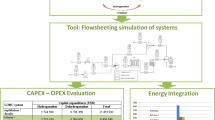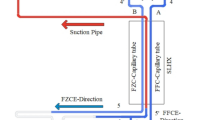Abstract
In this work, the cost optimal distribution of the overall conductance of all the heat exchangers is investigated from a thermoeconomic point-of-view in cascade refrigeration cycles using the endoreversible case. Non-dimensional cost functions are developed and investigated for a constant value of the rate of work, rate of cooling, rate of heat rejection and heat transfer rate for the cascade heat exchanger. These can be used to predict the minimum initial cost of the heat exchangers under the specified thermal conditions. All the cost functions showed an optimum point in relation to the absolute condenser temperature ratio (θ1) wherein the case of fixed heat rejection rate from the condenser gave the lowest cost values and the case of constant rate of work gave the highest cost values with it being 3 times higher at the optimum point. For the former case, a 1% increase in evaporator to condenser fluid temperature ratio (Φ) resulted in an average increase of 4.7% in the cost function value. For the case of fixed cooling rate, the corresponding cost function had an optimum value with respect to the non-dimensional temperature difference in the cascade heat exchanger. In this case, for a 5% increase in θ1, the cost value decreased by ~ 7%; although this decrease was larger for lower values of Φ. Also, investigation into the unit cost ratio of the system showed that the condenser contributed the most (42%-65%) to the total overall conductance.






Similar content being viewed by others
Abbreviations
- A :
-
Area (m2)
- F :
-
Non-dimensional cost ratio (–)
- G :
-
Unit cost conductance ratio (–)
- \(\dot{m}\) :
-
Mass flow rate (kg s−1)
- \(\dot{Q}\) :
-
Heat transfer rate (kW)
- T :
-
Absolute temperature (K)
- U :
-
Overall heat transfer coefficient (W m−2 K−1)
- Γ:
-
Total cost ($)
- γ :
-
Unit conductance cost ($ W−1 K)
- Φ:
-
Low-side Carnot absolute temperature ratio \(\left( { = {{T_{LC} } \mathord{\left/ {\vphantom {{T_{LC} } {T_{HC} }}} \right. \kern-0pt} {T_{HC} }}} \right)\)
- θ 1 :
-
High-side absolute temperature ratio for topping cycle \(\left( { = {{T_{HC} } \mathord{\left/ {\vphantom {{T_{HC} } {T_{H} }}} \right. \kern-0pt} {T_{H} }}} \right)\)
- θ 2 :
-
High-side absolute temperature ratio for cascade heat exchanger \(\left( { = {{T_{{{\text{CHX}},h}} } \mathord{\left/ {\vphantom {{T_{{{\text{CHX}},h}} } {T_{H} }}} \right. \kern-0pt} {T_{H} }}} \right)\)
- θ 3 :
-
Low-side absolute temperature ratio for cascade heat exchanger \(\left( { = {{T_{{{\text{CHX}},l}} } \mathord{\left/ {\vphantom {{T_{{{\text{CHX}},l}} } {T_{H} }}} \right. \kern-0pt} {T_{H} }}} \right)\)
- ξ :
-
Absolute temperature ratio \(\left( { = {{T_{L} } \mathord{\left/ {\vphantom {{T_{L} } {T_{H} }}} \right. \kern-0pt} {T_{H} }}} \right)\)
- a :
-
Fixed work rate
- b :
-
Fixed cooling rate
- C :
-
Reversible compartment
- c :
-
Fixed condenser heat rejection rate
- CHX:
-
Cascade heat exchanger
- d :
-
Constant heat transfer in the cascade heat exchanger
- H :
-
Hot end
- h :
-
High-side
- L :
-
Cold end
- l :
-
Low-side
- tot:
-
Total
References
Llopis, R.; Sánchez, D.; Sanz-Kock, C.; Cabello, R.; Torrella, E.: Energy and environmental comparison of two-stage solutions for commercial refrigeration at low temperature: fluids and systems. Appl. Energy 138, 133–142 (2015). https://doi.org/10.1016/j.apenergy.2014.10.069
Aktemur, C.; Ozturk, I.T.; Cimsit, C.: Comparative energy and exergy analysis of a subcritical cascade refrigeration system using low global warming potential refrigerants. Appl. Therm. Eng. (2021). https://doi.org/10.1016/j.applthermaleng.2020.116254
Bejan, A.: Theory of heat transfer-irreversible refrigeration plants. Int. J. Heat Mass Transf. 32, 1631–1639 (1989). https://doi.org/10.1016/0017-9310(89)90045-8
Bejan, A.: Power and refrigeration plants for minimum heat exchanger inventory. J. Energy Resour. Technol. 115, 148–150 (1993). https://doi.org/10.1115/1.2905982
Bejan, A.; Vargas, J.V.C.; Sokolov, M.: Optimal allocation of a heat-exchanger inventory in heat driven refrigerators. Int. J. Heat Mass Transf. 38, 2997–3004 (1995). https://doi.org/10.1016/0017-9310(95)00045-B
Chen, L.; Sun, F.; Wu, C.: Optimal allocation of heat-exchanger area for refrigeration and air-conditioning plants. Appl. Energy 77, 339–354 (2004). https://doi.org/10.1016/S0306-2619(03)00136-3
Klein, S.A.: Design considerations for refrigeration cycles. Int. J. Refrig. 15, 181–185 (1992). https://doi.org/10.1016/0140-7007(92)90009-J
Wu, C.: Maximum obtainable specific cooling load of a refrigerator. Energy Convers. Manag. 36, 7–10 (1995). https://doi.org/10.1016/0196-8904(94)00035-X
Chen, L.; Sun, F.; Chen, W.: Optimization of the specific rate of refrigeration in combined refrigeration cycles. Energy 20, 1049–1053 (1995). https://doi.org/10.1016/0360-5442(95)00051-H
Şahii̇n, B.; Kodal, A.: Steady-state thermodynamic analysis of a combined carnot cycle with internal irreversibility. Energy 20, 1285–1289 (1995). https://doi.org/10.1016/0360-5442(95)00076-S
Wu, C.; Chen, L.; Sun, F.: Effect ZOF heat transfer law on finite-time exergoeconomic performance of carnot heat pump. Energy Convers. Manag. 39, 579–588 (1998). https://doi.org/10.1016/S0196-8904(97)10012-7
Sahin, B.; Kodal, A.: Finite time thermoeconomic optimization for endoreversible refrigerators and heat pumps. Energy Convers. Manag. 40, 951–960 (1999). https://doi.org/10.1016/S0196-8904(98)00153-8
Antar, M.A.; Zubair, S.M.: Thermoeconomic considerations in the optimum allocation of heat transfer inventory for refrigeration and heat pump systems. J. Energy Resour. Technol. 124, 28–33 (2002). https://doi.org/10.1115/1.1446070
Klein, S.A.; Reindl, D.T.: The relationship of optimum heat exchanger allocation and minimum entropy generation rate for refrigeration cycles. J. Energy Resour. Technol. 120, 172–178 (1998). https://doi.org/10.1115/1.2795030
Morales, M.J.; Sherif, S.A.: Optimal allocation of heat exchanger inventory of a two-stage vapor compression cycle for cost minimization. IASME Trans. Am. Soc. Mech. Eng. 2, 32–38 (2005)
Qureshi, B.A.; Zubair, S.M.: Cost optimization of heat exchanger inventory for mechanical subcooling refrigeration cycles. Int. J. Refrig. 36, 1243–1253 (2013). https://doi.org/10.1016/j.ijrefrig.2013.02.011
Durmayaz, A.; Sogut, O.S.; Sahin, B.; Yuvaz, H.: Optimization of thermal systems based on finite-time thermodynamics and thermoeconomics. Prog. Energy Combust. Sci. 30, 175–217 (2004). https://doi.org/10.1016/j.pecs.2003.10.003
Tyagi, S.K.; Chen, G.M.; Wang, Q.; Kaushik, S.C.: A new thermoeconomic approach and parametric study of an irreversible regenerative Brayton refrigeration cycle. Int. J. Refrig. 29, 1167–1174 (2006). https://doi.org/10.1016/j.ijrefrig.2006.01.003
Kızılkan, Ö.; Şencan, A.; Kalogirou, S.A.: Thermoeconomic optimization of a LiBr absorption refrigeration system. Chem. Eng. Process. 46, 1376–1384 (2007). https://doi.org/10.1016/j.cep.2006.11.007
Zhou, T.; Liu, J.; Liu, J.; Ren, J.; Ding, S.; Yang, S.: Energy-exergy-economic-environmental (4E) analysis and multi-objective optimization of a cascade LiBr/H2O refrigeration and Organic Rankine cycle integrated system for power generation. Appl. Therm. Eng. (2023). https://doi.org/10.1016/j.applthermaleng.2023.120142
Yu, M.; Liu, X.; Liu, Z.; Yang, S.: Energy, exergy, economic and environmental (4E) analysis of a novel power/refrigeration cascade system to recover low-grade waste heat at 90–150 °C. J. Clean. Prod. (2022). https://doi.org/10.1016/j.jclepro.2022.132353
Golbaten Mofrad, K.; Zandi, S.; Salehi, G.; Khoshgoftar Manesh, M.H.: 4E analyses and multi-objective optimization of cascade refrigeration cycles with heat recovery system. Therm. Sci. Eng. Prog. (2020). https://doi.org/10.1016/j.tsep.2020.100613
Hu, R.; Liu, X.; Zhang, X.; Yang, L.: Analysis of energy, economy, and carbon emission of nested cascade refrigeration cycle with heat recovery system. Int. J. Refrig. 136, 94–102 (2022). https://doi.org/10.1016/j.ijrefrig.2022.01.016
Acknowledgements
The authors would like to acknowledge the support provided by King Fahd University of Petroleum and Minerals (KFUPM) for funding this work through project # SB191026.
Author information
Authors and Affiliations
Corresponding author
Rights and permissions
Springer Nature or its licensor (e.g. a society or other partner) holds exclusive rights to this article under a publishing agreement with the author(s) or other rightsholder(s); author self-archiving of the accepted manuscript version of this article is solely governed by the terms of such publishing agreement and applicable law.
About this article
Cite this article
Qureshi, B.A., Zubair, S.M. Cost Optimization of Heat Exchanger Inventory in Cascade Refrigeration Cycles. Arab J Sci Eng 48, 12513–12522 (2023). https://doi.org/10.1007/s13369-023-07865-y
Received:
Accepted:
Published:
Issue Date:
DOI: https://doi.org/10.1007/s13369-023-07865-y




